Carbon Footprints of Urban Residential Buildings: A Household Survey-Based Approach
Abstract
:1. Introduction
2. Materials and Methods
2.1. Study Area
2.2. Survey Design and Data Collection
2.3. Calculation Methodology
2.3.1. Carbon Footprints from the Building Operational Stage
2.3.2. Carbon Footprints Excluding the Operational Stage
3. Results
3.1. Household Distribution of Carbon Footprints
3.2. Urban Residential Building Carbon Footprints at the Community Level
3.3. Carbon Footprints of Urban Residential Buildings with Different Socio-Economic Attributes
3.4. Total Urban Residential Building Carbon Footprints in Xiamen City
3.5. Energy Awareness
4. Discussion
5. Conclusions
Supplementary Materials
Acknowledgments
Author Contributions
Conflicts of Interest
References
- Lin, J.; Kang, J.; Khann, N.; Shi, L.; Zhao, X.; Liao, J. Scenario Analysis of Urban GHG Peak and Mitigation Co-benefits: A Case Study of Xiamen City, China. J. Clean. Prod. 2017, 171, 972–983. [Google Scholar] [CrossRef]
- Dong, F.; Long, R.; Yu, B.; Wang, Y.; Li, J.; Wang, Y.; Dai, Y.; Yang, Q.; Chen, H. How can China allocate CO2 reduction targets at the provincial level considering both equity and efficiency Evidence from its Copenhagen Accord pledge. Resour. Conserv. Recycl. 2018, 130, 31–43. [Google Scholar] [CrossRef]
- Climate Action Tracker. Available online: http://www.climateactiontracker.org/countries/china.html (accessed on 6 November 2017).
- Feng, K.; Hubacek, K. Carbon implications of China’s urbanization. Energy Ecol. Environ. 2016, 1, 39–44. [Google Scholar] [CrossRef]
- Wiedenhofer, D.; Guan, D.; Liu, Z.; Meng, J.; Zhang, N.; Wei, Y.M. Unequal household carbon footprints in China. Nat. Clim. Chang. 2017, 7, 75–80. [Google Scholar] [CrossRef]
- Jones, C.; Kammen, D.M. Spatial distribution of U.S. household carbon footprints reveals suburbanization undermines greenhouse gas benefits of urban population density. Environ. Sci. Technol. 2014, 48, 895–902. [Google Scholar] [CrossRef] [PubMed]
- Tukker, A.; Huppes, G.; Guinée, J.; Heijungs, R.; Koning, A.D.; Oers, L.V.; Suh, S.; Geerken, T.; Holderbeke, M.V.; Jansen, B.; et al. Report: Environmental Impact of Products; European Commission: Brussels, Belgium; Luxembourg, 2006. [Google Scholar]
- Saner, D.; Beretta, C.; Jäggi, B.; Juraske, R.; Stoessel, F.; Hellweg, S. FoodPrints of households. Int. J. Life Cycle Assess. 2015, 21, 654–663. [Google Scholar] [CrossRef]
- Ye, H.; Wang, K.; Zhao, X.; Chen, F.; Li, X.; Pan, L. Relationship between construction characteristics and carbon emissions from urban household operational energy usage. Energy Build. 2011, 43, 147–152. [Google Scholar] [CrossRef]
- Chau, C.K.; Hui, W.K.; Ng, W.Y.; Powell, G. Assessment of CO2 emissions reduction in high-rise concrete office buildings using different material use options. Resour. Conserv. Recycl. 2012, 61, 22–34. [Google Scholar] [CrossRef]
- Pal, S.K.; Takano, A.; Alanne, K.; Siren, K. A life cycle approach to optimizing carbon footprint and costs of a residential building. Build. Environ. 2017, 123, 146–162. [Google Scholar] [CrossRef]
- Ye, H.; Ren, Q.; Hu, X.; Lin, T.; Xu, L.; Li, X.; Zhang, G.; Shi, L.; Pan, B. Low-carbon behavior approaches for reducing direct carbon emissions: Household energy use in a coastal city. J. Clean. Prod. 2017, 141, 128–136. [Google Scholar] [CrossRef]
- Ding, G.; Forsythe, P.J. Sustainable construction: Life cycle energy analysis of construction on sloping sites for residential buildings. Constr. Manag. Econ. 2013, 31, 254–265. [Google Scholar] [CrossRef]
- Asif, M.; Muneer, T.; Kelley, R. Life cycle assessment: A case study of a dwelling home in Scotland. Build. Environ. 2007, 42, 1391–1394. [Google Scholar] [CrossRef]
- Ahn, C.; Lee, S.; Peña-Mora, F.; Abourizk, S. Toward Environmentally Sustainable Construction Processes: The U.S. and Canada’s Perspective on Energy Consumption and GHG/CAP Emissions. Sustainability 2010, 2, 354–370. [Google Scholar] [CrossRef]
- Zhang, X.; Wang, F. Life-cycle assessment and control measures for carbon emissions of typical buildings in China. Build. Environ. 2015, 86, 89–97. [Google Scholar] [CrossRef]
- Hu, Y.; Lin, J.; Cui, S.; Khanna, N.Z. Measuring Urban Carbon Footprint from Carbon Flows in the Global Supply Chain. Environ. Sci. Technol. 2016, 50, 6154–6163. [Google Scholar] [CrossRef] [PubMed]
- Creutzig, F.; Baiocchi, G.; Bierkandt, R.; Pichler, P.P.; Seto, K.C. Global typology of urban energy use and potentials for an urbanization mitigation wedge. Proc. Natl. Acad. Sci. USA 2015, 112, 6283–6288. [Google Scholar] [CrossRef] [PubMed]
- Lin, J.; Cao, B.; Cui, S.; Wang, W.; Bai, X. Evaluating the effectiveness of urban energy conservation and GHG mitigation measures: The case of Xiamen city, China. Energy Policy 2010, 38, 5123–5132. [Google Scholar] [CrossRef]
- Laine, J.; Ottelin, J.; Heinonen, J.; Junnila, S. Consequential Implications of Municipal Energy System on City Carbon Footprints. Sustainability 2017, 9, 1801. [Google Scholar] [CrossRef]
- Kennedy, C.; Ibrahim, N.; Hoornweg, D. Low-carbon infrastructure strategies for cities. Nat. Clim. Chang. 2014, 4, 343–346. [Google Scholar] [CrossRef]
- Duren, R.M.; Miller, C.E. Measuring the carbon emissions of megacities. Nat. Clim. Chang. 2012, 2, 560–562. [Google Scholar] [CrossRef]
- Grimm, N.B.; Faeth, S.H.; Golubiewski, N.E.; Redman, C.L.; Wu, J.B.X.; Briggs, J.M. Global change and the ecology of cities. Science 2008, 319, 756–760. [Google Scholar] [CrossRef] [PubMed]
- Huang, W.; Li, F.; Cui, S.; Li, F.; Huang, L.; Lin, J. Carbon Footprint and Carbon Emission Reduction of Urban Buildings: A Case in Xiamen City, China. Procedia Eng. 2017, 198, 1007–1017. [Google Scholar] [CrossRef]
- Li, B.; Yao, R. Urbanisation and its impact on building energy consumption and efficiency in China. Renew. Energy 2009, 34, 1994–1998. [Google Scholar] [CrossRef]
- Zhang, X.; Wang, F. Assessment of embodied carbon emissions for building construction in China: Comparative case studies using alternative methods. Energy Build. 2016, 130, 330–340. [Google Scholar] [CrossRef]
- Macias, J.; Iturburu, L.; Rodriguez, C.; Agdas, D.; Boero, A.; Soriano, G. Embodied and operational energy assessment of different construction methods employed on social interest dwellings in Ecuador. Energy Build. 2017, 151, 107–120. [Google Scholar] [CrossRef]
- Saner, D.; Vadenbo, C.; Steubing, B.; Hellweg, S. Regionalized LCA-based optimization of building energy supply: Method and case study for a Swiss municipality. Environ. Sci. Technol. 2014, 48, 7651–7659. [Google Scholar] [CrossRef] [PubMed]
- Ardente, F.; Beccali, M.; Cellura, M.; Mistretta, M. Energy and environmental benefits in public buildings as a result of retrofit actions. Renew. Sustain. Energy Rev. 2011, 15, 460–470. [Google Scholar] [CrossRef]
- Beccali, M.; Cellura, M.; Fontana, M.; Longo, S.; Mistretta, M. Energy retrofit of a single-family house: Life cycle net energy saving and environmental benefits. Renew. Sustain. Energy Rev. 2013, 27, 283–293. [Google Scholar] [CrossRef]
- Kang, N.N.; Cho, S.H.; Kim, J.T. The energy-saving effects of apartment residents’ awareness and behavior. Energy Build. 2012, 46, 112–122. [Google Scholar] [CrossRef]
- Guo, F.; Kurdgelashvili, L.; Bengtsson, M.; Akenji, L. Analysis of achievable residential energy-saving potential and its implications for effective policy interventions: A study of Xiamen city in southern China. Renew. Sustain. Energy Rev. 2016, 62, 507–520. [Google Scholar] [CrossRef]
- Junnila, S.; Horvath, A. Life-Cycle Environmental Effects of an Office Building. J. Infrastruct. Syst. 2003, 9, 157–166. [Google Scholar] [CrossRef]
- Iyer-Raniga, U.; Wong, J.P.C. Evaluation of whole life cycle assessment for heritage buildings in Australia. Build. Environ. 2012, 47, 138–149. [Google Scholar] [CrossRef]
- Kang, J.; Lin, J.; Zhao, X.; Zhao, S.; Kou, L. Decomposition of the Urban Water Footprint of Food Consumption: A Case Study of Xiamen City. Sustainability 2017, 9, 135. [Google Scholar] [CrossRef]
- Municipal Bureau of Statistics (XMBS). Yearbook of Xiamen Special Economic Zone; China Statistics Press: Beijing, China, 2006. Available online: http://www.stats-xm.gov.cn/2006/ (accessed on 31 January 2007).
- Municipal Bureau of Statistics (XMBS). Yearbook of Xiamen Special Economic Zone; China Statistics Press: Beijing, China, 2016. Available online: http://www.stats-xm.gov.cn/2016/ (accessed on 8 October 2016).
- Lin, J.; Hu, Y.; Cui, S.; Kang, J.; Ramaswami, A. Tracking urban carbon footprints from production and consumption perspectives. Environ. Res. Lett. 2015, 10, 054001. [Google Scholar] [CrossRef]
- Xiao, L.; Qiu, Q.; Gao, L. Chinese Housing Reform and Social Sustainability: Evidence from Post-Reform Home Ownership. Sustainability 2016, 8, 1053. [Google Scholar] [CrossRef]
- Gao, L.; Li, X.; Wang, G.; Qiu, Q.; Cui, S.; Zhao, Q. Survey Site Selection Based on the Spatial Sampling Theory—A Case Study in Xiamen Island. J. Geoinf. Sci. 2010, 2, 364–385. [Google Scholar] [CrossRef]
- Li, F.; Cui, S.; Gao, L.; Lin, J.; Yu, Y. Carbon Footprint Comparison of Residential Buildings between Brick and Concrete Structure and Shear Wall Structure in Xiamen City. Environ. Sci. Technol. 2012, 35, 18–22. (In Chinese) [Google Scholar]
- Ministry of Housing and Urban-Rural Development, P.C. Code for the Design of Civil Buildings; Ministry of Housing and Urban-Rural Development, P.C.: Beijing, China, 2005. [Google Scholar]
- Sun, K.; Hong, T. A framework for quantifying the impact of occupant behavior on energy savings of energy conservation measures. Energy Build. 2017, 146, 383–396. [Google Scholar] [CrossRef]
- Asdrubali, F.; Baldassarri, C.; Fthenakis, V. Life cycle analysis in the construction sector: Guiding the optimization of conventional Italian buildings. Energy Build. 2013, 64, 73–89. [Google Scholar] [CrossRef]
- Gustavsson, L.; Joelsson, A. Life cycle primary energy analysis of residential buildings. Energy Build. 2010, 42, 210–220. [Google Scholar] [CrossRef]
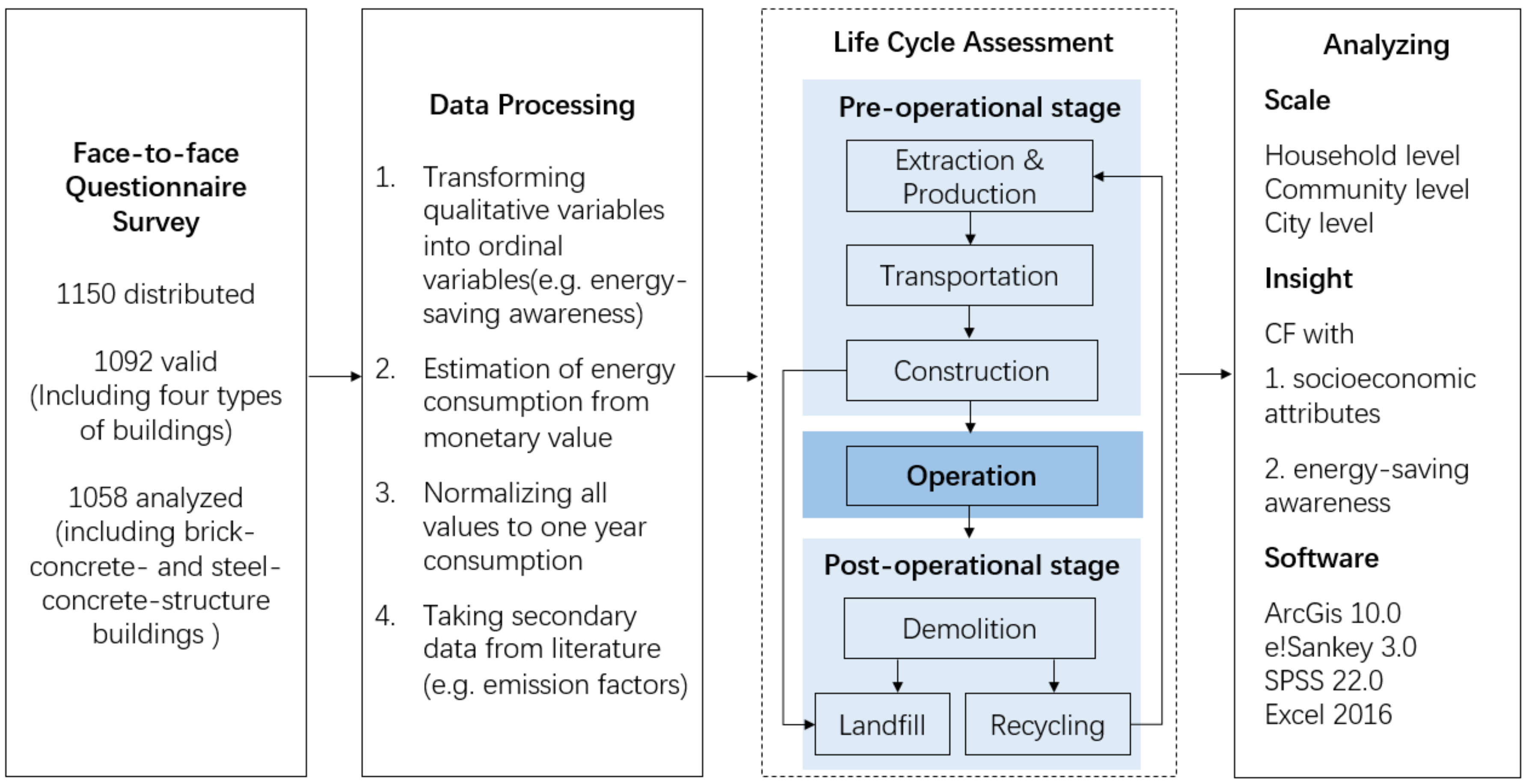
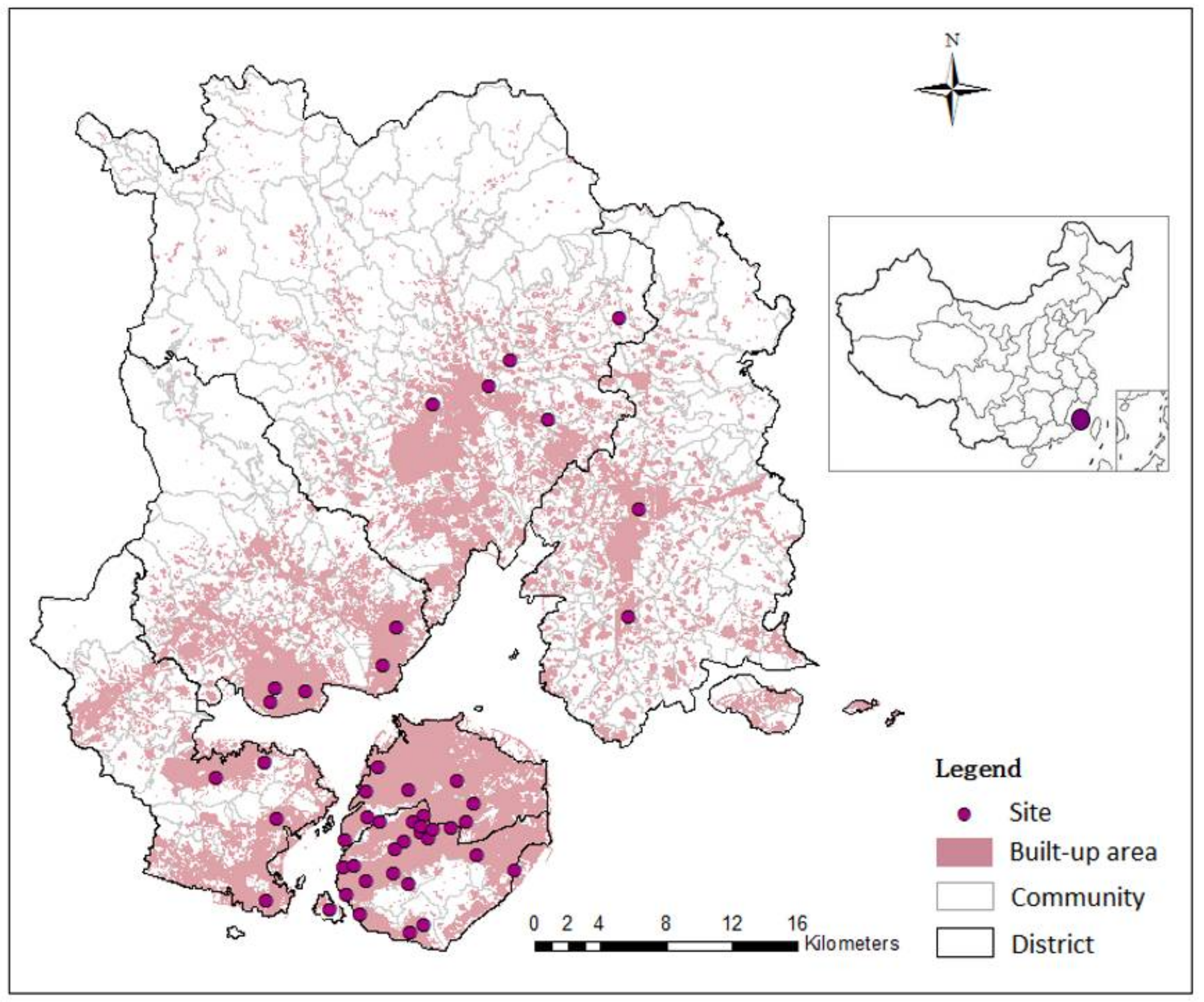
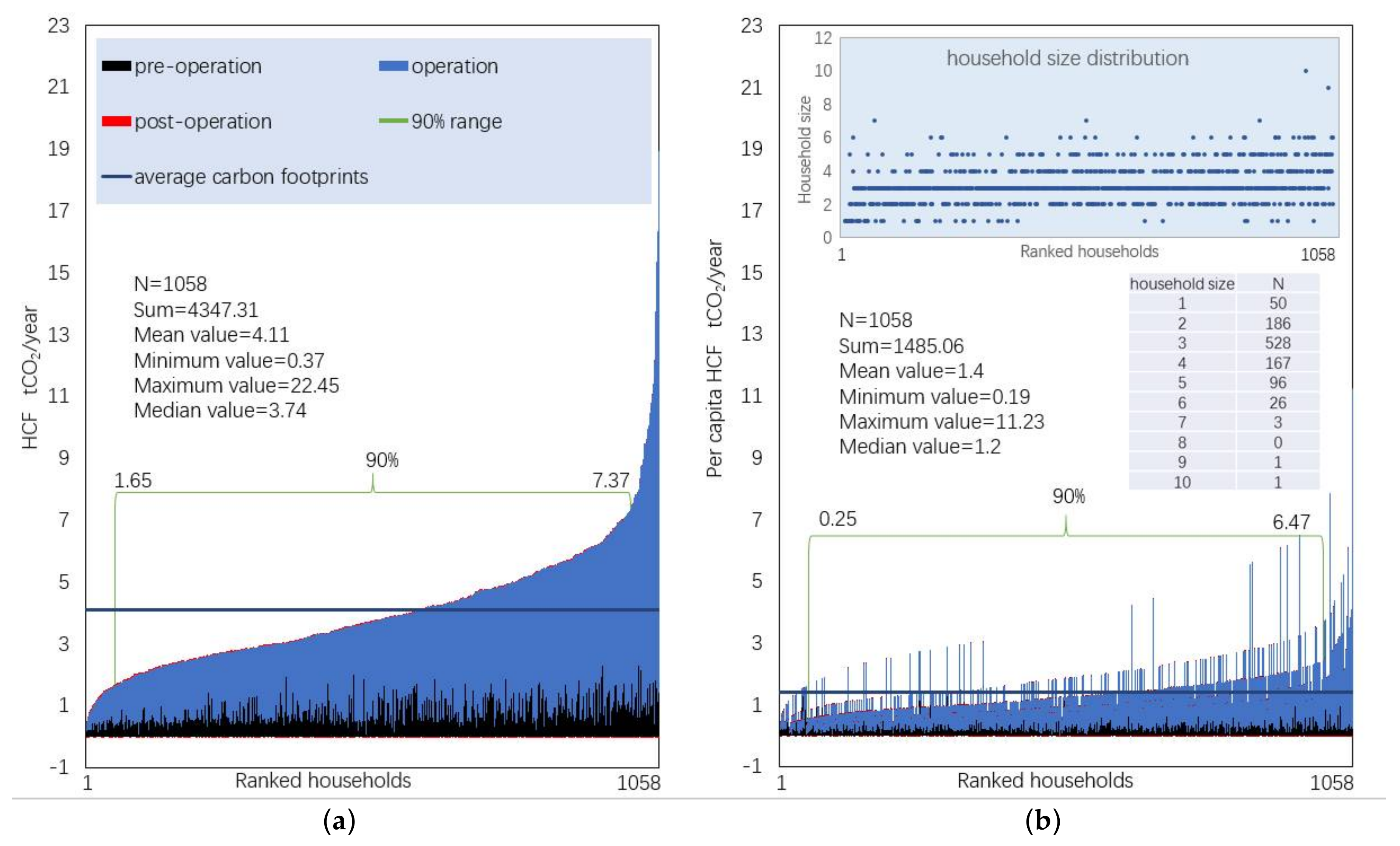

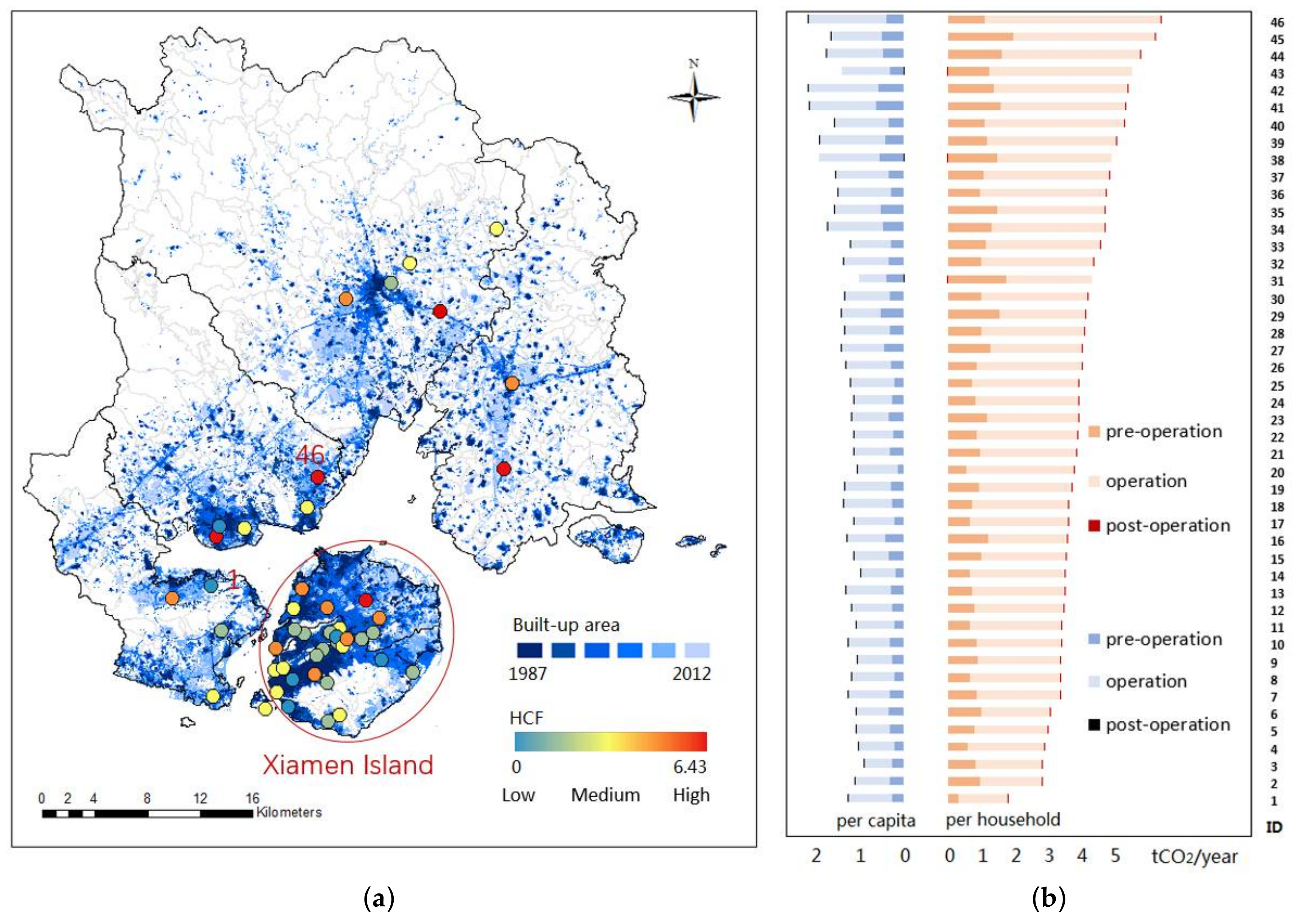
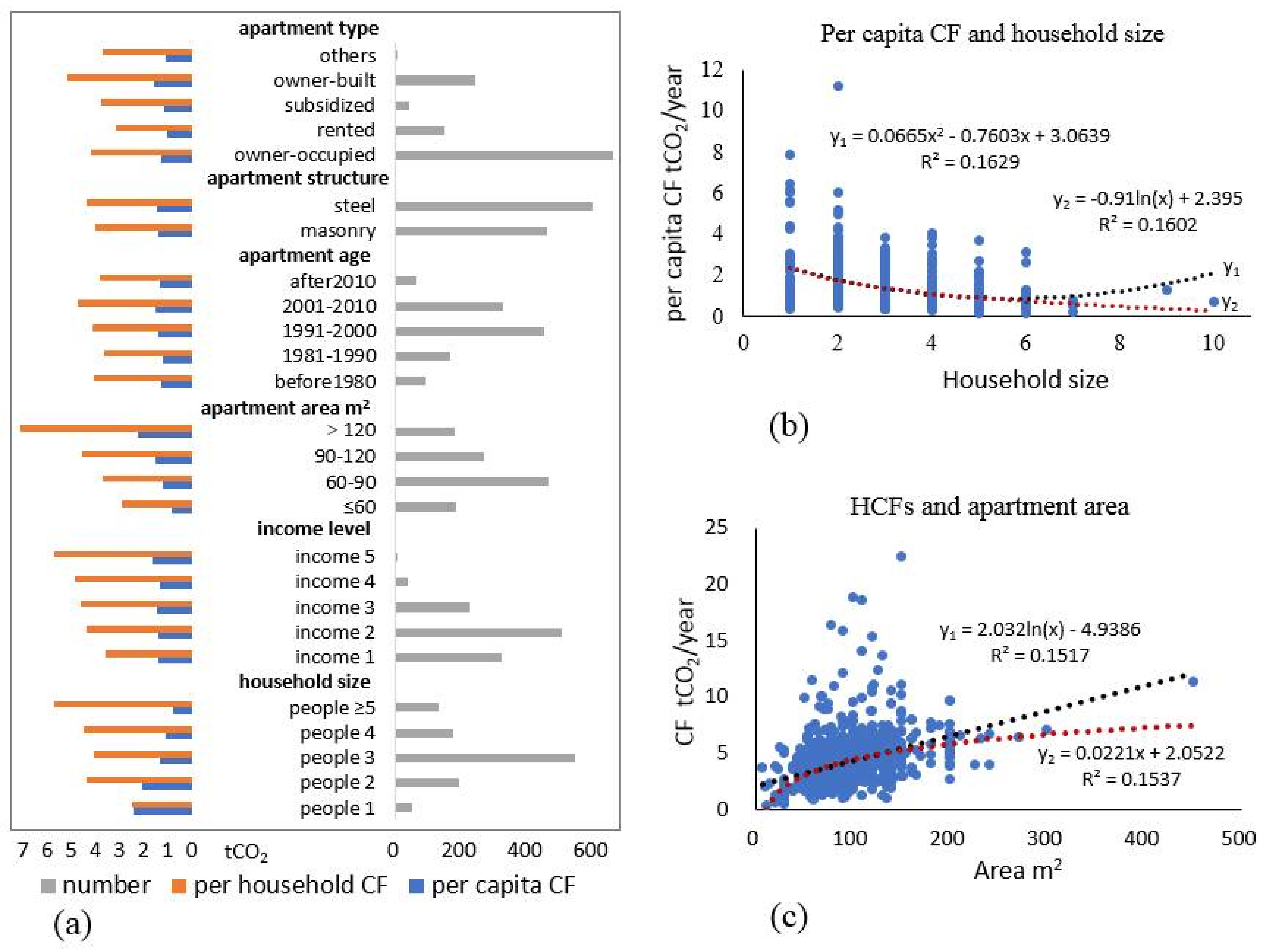

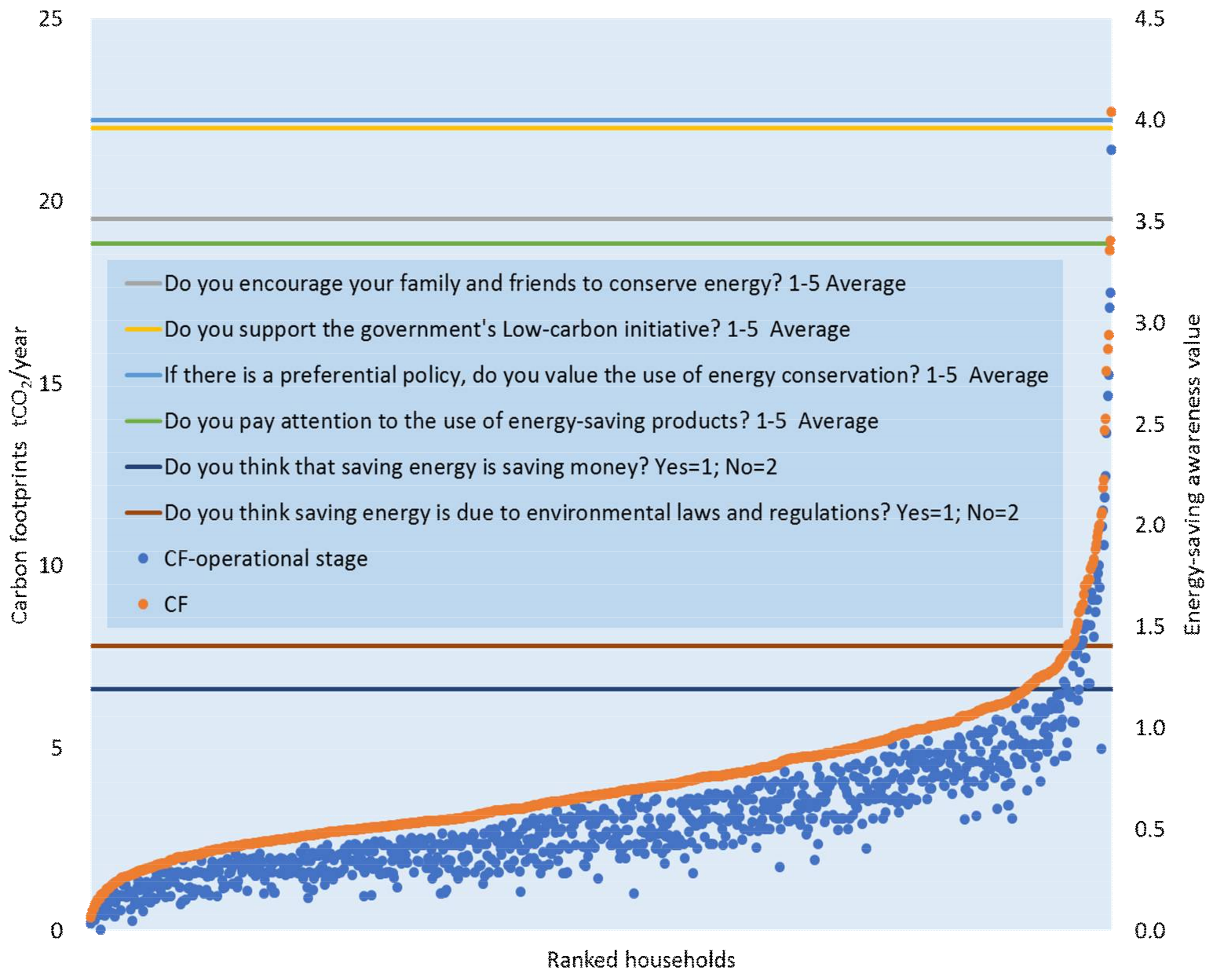
| Steel-Concrete Structure | Masonry-Concrete Structure | |
|---|---|---|
| Extraction and production stage | 0.6734 | 0.3221 |
| Materials transportation stage | 0.0045 | 0.0033 |
| Construction stage | 0.0337 | 0.0161 |
| Demolition stage | 0.0303 | 0.0145 |
| Recycle stage | −0.0319 | −0.0068 |
| ESP | ECE | SGI | EUV | SESM | ELR | CF | EU | ||
|---|---|---|---|---|---|---|---|---|---|
| ESP | 1.000 | 0.497 ** | 0.397 ** | 0.457 ** | 0.032 | 0.051 | 0.020 | 0.038 | Energy-saving products |
| ECE | 0.497 ** | 1.000 | 0.476 ** | 0.442 ** | 0.015 | 0.015 | 0.028 | 0.042 | Energy conservation encouragement |
| SGI | 0.397 ** | 0.476 ** | 1.000 | 0.659 ** | 0.012 | 0.006 | −0.013 | 0.007 | Support to government’s initiative |
| EUV | 0.457 ** | 0.442 ** | 0.659 ** | 1.000 | −0.016 | −0.007 | −0.010 | 0.004 | Energy use value |
| SESM | 0.032 | 0.015 | 0.012 | −0.016 | 1.000 | 0.238 ** | −0.031 | −0.033 | Saving energy is saving money |
| ELR | 0.051 | 0.015 | 0.006 | −0.007 | 0.238 ** | 1.000 | −0.035 | −0.030 | Environmental laws & regulations |
| CF | 0.020 | 0.028 | −0.013 | −0.010 | −0.031 | −0.035 | 1.000 | 0.946 ** | Carbon footprints |
| EU | 0.038 | 0.042 | 0.007 | 0.004 | −0.033 | −0.030 | 0.946 ** | 1.000 | Energy use |
© 2018 by the authors. Licensee MDPI, Basel, Switzerland. This article is an open access article distributed under the terms and conditions of the Creative Commons Attribution (CC BY) license (http://creativecommons.org/licenses/by/4.0/).
Share and Cite
Yan, X.; Cui, S.; Xu, L.; Lin, J.; Ali, G. Carbon Footprints of Urban Residential Buildings: A Household Survey-Based Approach. Sustainability 2018, 10, 1131. https://doi.org/10.3390/su10041131
Yan X, Cui S, Xu L, Lin J, Ali G. Carbon Footprints of Urban Residential Buildings: A Household Survey-Based Approach. Sustainability. 2018; 10(4):1131. https://doi.org/10.3390/su10041131
Chicago/Turabian StyleYan, Xiaomei, Shenghui Cui, Lilai Xu, Jianyi Lin, and Ghaffar Ali. 2018. "Carbon Footprints of Urban Residential Buildings: A Household Survey-Based Approach" Sustainability 10, no. 4: 1131. https://doi.org/10.3390/su10041131






